Last Updated on March 14, 2024 by Aftab Tariq
Types of parrots include macaws, cockatoos, lovebirds, conures, African greys, Amazon parrots, and budgies. These birds vary in size, color, personality, and care needs, making each type unique and interesting. Wild And Free Says,
“Embracing the untamed essence, one parrot squawk at a time.”
Dr. Nemetz Says,
“Voyaging through life’s horizons, steered by the compass of my parrot’s soul.”
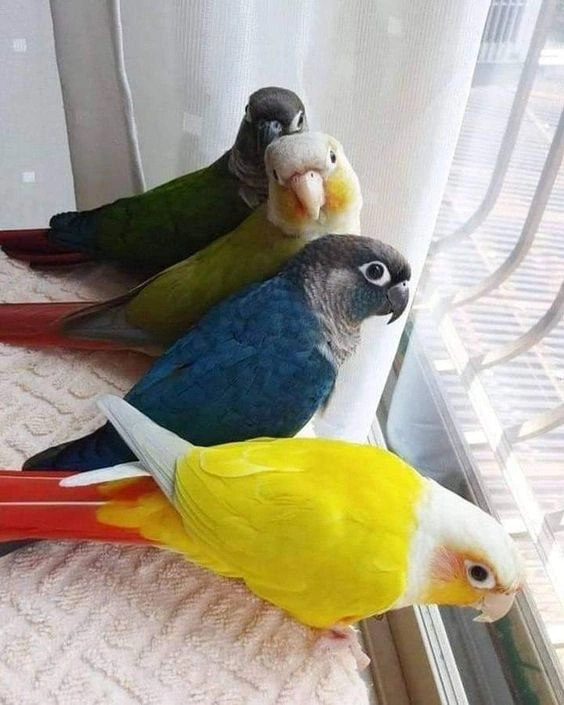
There are more than 350 kinds of parrots. They are colorful and smart birds. Parrots like to live in warm places such as tropical islands and rainforests. Parrots have special feet with four toes. Two toes point forward and two points backward. This helps them grip things tightly, even in tricky places.
Parrots also have curved beaks that they are very good at using. They use their beaks to climb, hold objects, and eat. Since their beaks keep growing, it’s important to give them things to chew on. Now, let’s explore 13 types of parrots that are good as pets and also types of parrots that talk.
13 Types Of Parrots
Here is the list of the top 13 types of parrots with names.
1: Amazon Parrot
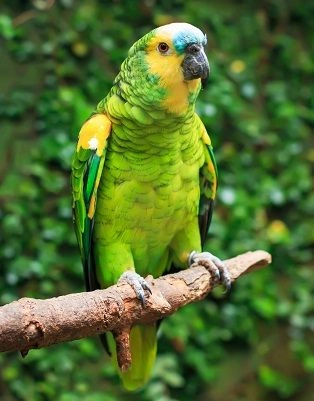
Amazon parrots are very lively and love to play. They are also famous for their ability to talk. These parrots can adjust well to different environments, but it’s important to keep them mentally active every day. If they don’t get enough care and attention, they might start behaving badly.
| Characteristic | Description |
| Size | Medium |
| Weight | 13 – 18 ounces |
| Life Expectancy | 30 – 50 years |
| Color | Green (male), Red (female) |
| Personality Traits | Caring, tranquil, gentle |
| Physical Characteristics | Fur-like feathers |
2: Cockatiel Parrots
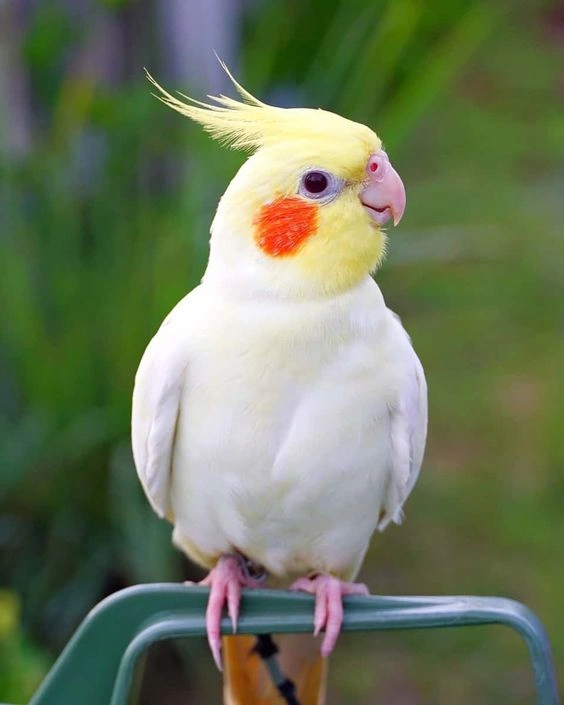
Cockatiels are smaller parrots, and they enjoy being close to people. They like being petted and are happy when they’re around you. They’re intelligent birds and love picking up new tricks, especially when they get treats for doing well.
Although not all cockatiels can talk, they’re great at copying other bird sounds. To keep your cockatiel from feeling lonely, it’s a good idea to give them a companion.
| Characteristic | Description |
| Size | Small |
| Weight | 2 – 4 ounces |
| Life Expectancy | 15 – 20 years |
| Personality Traits | Gentle, affectionate, cheerful |
| Physical Characteristics | Medium-gray body, white edges on the wings and face, yellow/white crest; Small dark eyes and long tail |
3: Cockatoo Parrots

Cockatoos are lively birds often called “velcro birds” because they like to stick close to their owners. They enjoy chatting and being around people.
Cockatoos are playful creatures, and having different toys for them to play with keeps them happy. However, they are the noisiest of all parrots, so they might not be suitable for people who live in small spaces.
| Characteristic | Description |
| Size | Medium to large |
| Weight | 10.5 – 40 ounces |
| Life Expectancy | 30 – 70 years |
| Color | White, Black, Gray |
| Personality Traits | Excitable, cuddly, lively |
| Physical Characteristics | Splotches of yellow, pink or red on crests and tails |
4: Caique Parrot
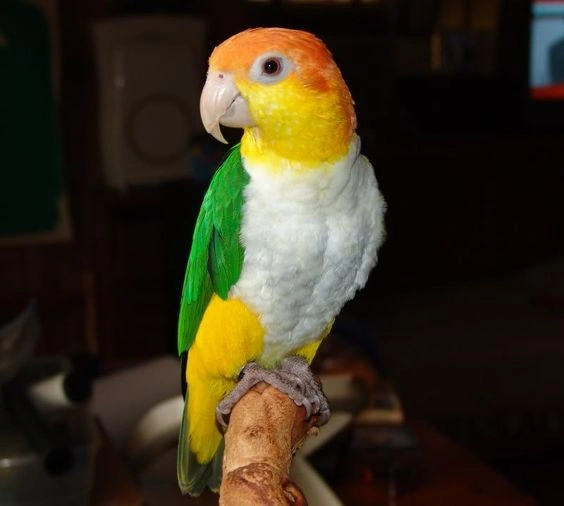
Caique parrots are friendly birds that like to bond with people. They’re affectionate and love spending time playing or relaxing with their human friends. They’re also curious and playful, and they prefer walking on the ground rather than flying around.
While Caique parrots may not be as good at talking as Amazon parrots, they are skilled at singing, whistling, and imitating sounds from their environment.
| Characteristic | Description |
| Size | Small |
| Weight | 5 – 6 ounces |
| Life Expectancy | 25 – 40 years |
| Personality Traits | Mischievous, quick learners, energetic |
| Physical Characteristics | Black-headed, white-bellied, green tail feathers and yellow thigh feathers; Hinged upper beak |
5: Conure Parrot
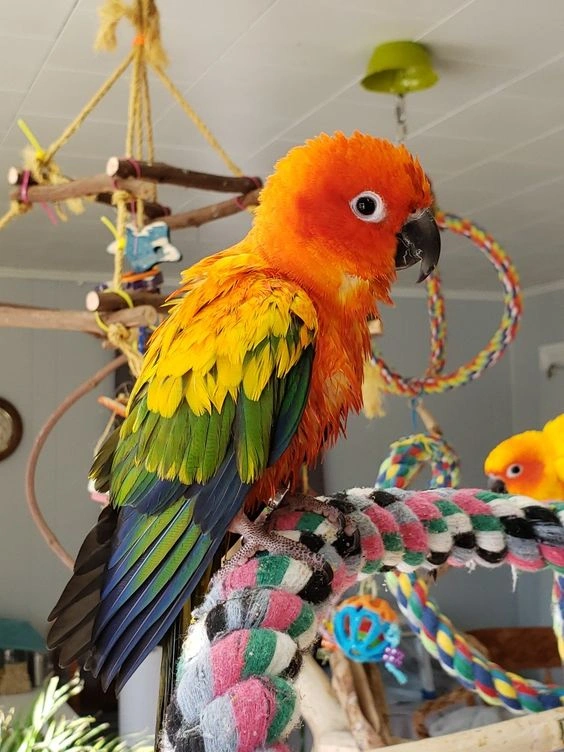
Conure parrots are popular for their beauty, smarts, and how they like to hang out with people. They make great pets for families and can learn cool tricks.
However, living in an apartment with a conure might not be ideal because they can get really loud when they’re bored or want attention. To keep them cheerful, make sure they have plenty of toys to play with and things to chew on that won’t hurt them.
| Characteristic | Description |
| Size | Small to medium |
| Weight | 2.3 – 7 ounces |
| Life Expectancy | 15 – 30 years |
| Color | Blue, Green, Orange, Yellow |
| Personality Traits | Playful, friendly, comical |
| Physical Characteristics | Long tail |
6: Eclectus Parrot
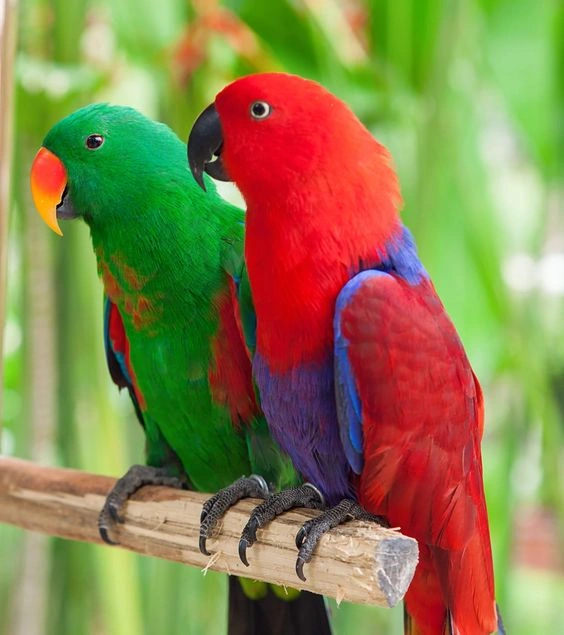
Eclectus parrots, similar to other parrots, are loving birds who thrive on getting lots of attention. They enjoy being part of the family’s daily routines and are content when they feel included.
These parrots are vocal and can be taught to say many words easily. Luckily, they’re not as loud as Cockatoos, which makes them more suitable for quieter households.
| Characteristic | Description |
| Size | Medium |
| Weight | 13 – 18 ounces |
| Life Expectancy | 30 – 50 years |
| Color | Green (male), Red (female) |
| Personality Traits | Caring, tranquil, gentle |
| Physical Characteristics | Fur-like feathers |
7: Macaw parrot
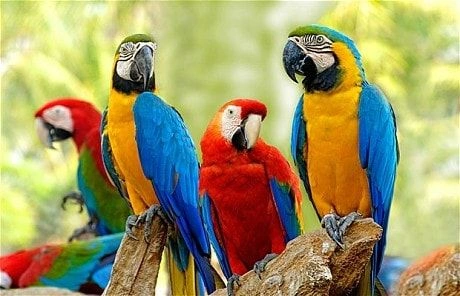
Macaws are stunning, large parrots with vibrant colors, often called the gentle giants of the parrot family. They’re super smart and can figure out tricky puzzles without much trouble. But they really need social time with other birds or people, or they might start causing chaos around the house.
As pets, macaws are wonderful, but they do require a lot of attention and care. They can get bored and lonely easily, which leads to some loud moments, including some ear-piercing noises for about 10 minutes every day.
| Characteristic | Description |
| Size | Large |
| Weight | 32 – 64 ounces |
| Life Expectancy | 50 – 75 years |
| Color | Scarlet, Green, Blue and gold, Hyacinth |
| Personality Traits | Sweet, intelligent, hardy |
| Physical Characteristics | Rings of skin around their eyes, long tail |
8: Lovebird Parrots
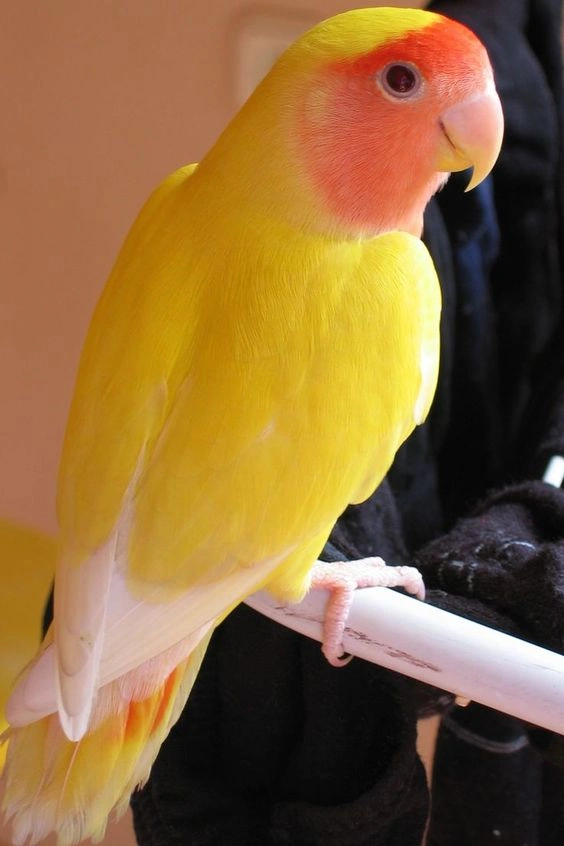
Lovebirds are full of personality. They’re energetic and need safe spots to play outside their cages every day. You can teach them fun tricks like spinning, waving, and ringing bells.
These birds crave attention, and if they feel ignored, they might not want you to touch them. If you enjoy the sound of birds singing and whistling throughout the day, lovebirds could be the perfect parrot for you.
| Characteristic | Description |
| Size | Small |
| Weight | 1.5 – 2 ounces |
| Life Expectancy | Up to 20 years |
| Color | Peach-faced, a combination of green, yellow, and orange; Black-faced, Violet, Red and dark orange |
| Personality Traits | Bold, curious, feisty |
| Physical Characteristics | Short tail, rounded beak |
9: Parrotlet Parrots
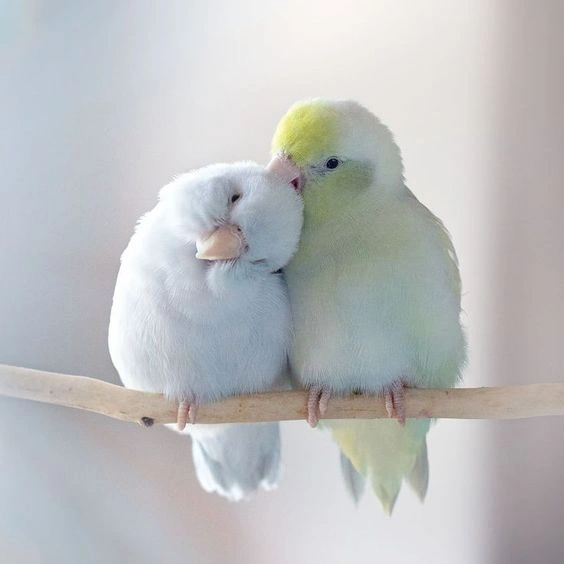
Parrotlets are the tiniest members of the parrot family and can be wonderful pets when they are trained and cared for well. They like being around people and aren’t too loud, which makes them great for families who live in apartments.
Parrotlets are lively birds and need things to keep them busy and happy like toys to play with, especially when their owners aren’t around much.
| Characteristic | Description |
| Size | Small to medium |
| Weight | 1.1 – 1.4 ounces |
| Life Expectancy | 7 – 15 years |
| Color | White-based: sky blue, cobalt, mauve, gray, violet, white; |
| Personality Traits | Docile, active, social |
| Physical Characteristics | Long, tapered tail feathers |
10: Parakeet Parrots
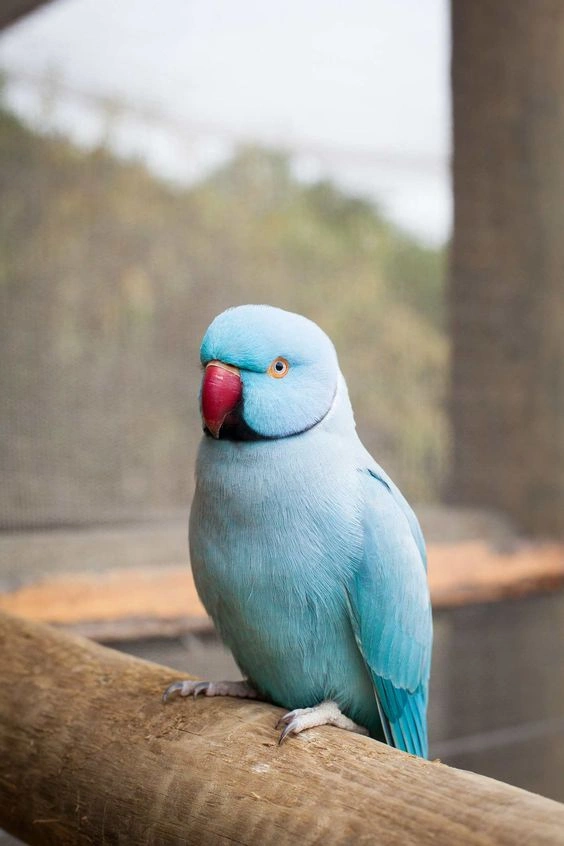
Parakeets, also called budgies, are tiny parrots often kept as pets. Surprisingly, they’re better talkers than bigger parrots like macaws and cockatoos. They can mimic human speech and sounds they hear around them, making up their tunes.
These little birds love hanging out with people and other birds. But if they’re left alone too much, they might get sad and even start pulling out their feathers.
| Characteristic | Description |
| Size | Small to medium |
| Weight | 1.1 – 1.4 ounces |
| Life Expectancy | 7 – 15 years |
| Color | White-based: sky blue, cobalt, mauve, gray, violet, white |
| Personality Traits | Docile, active, social |
| Physical Characteristics | Long, tapered tail feathers |
11: Pionus Parrot
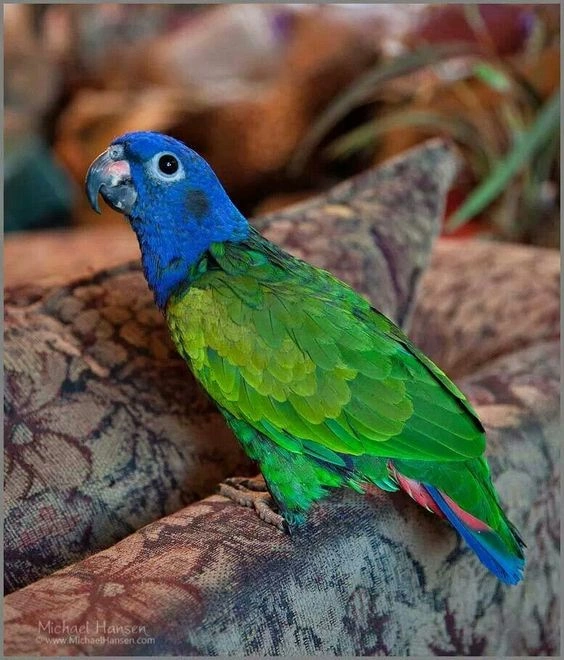
Pionus parrots enjoy spending time with their human family and are good at keeping themselves entertained with toys.
Like many other parrots, they need time outside of their cage every day to stay happy and healthy. While they’re usually quiet, they might get louder if they’re in a noisy place for too long.
| Characteristic | Description |
| Size | Medium |
| Weight | 8 – 9 ounces |
| Life Expectancy | 25 – 40 years |
| Color | Blue-headed, White-capped, Bronze-winged, Dark brownish green, Dark colored |
| Personality Traits | Easy-going, gentle, independent |
| Physical Characteristics | Short, square-shaped tail |
12: Quaker Parakeet

Quaker parakeets are named for their habit of shaking when they’re happy or annoyed. They’re clever birds that can learn to talk with clear voices, picking up lots of words. These parrots are social creatures and like being around people or other Quakers.
Even if they’re kept in pairs, they’ll still bond closely with their owners through interaction. If you want a medium-sized parrot that can talk, Quakers is what you’re looking for.
| Characteristic | Description |
| Size | Medium |
| Weight | 3 – 5 ounces |
| Life Expectancy | 20 – 30 years |
| Personality Traits | Confident, social, outgoing |
13: Senegal Parrot

Senegal parrots are fond of their human companions and enjoy perching on their shoulders for long periods. They don’t necessarily need another bird for the company as long as they get plenty of attention from their owners.
While they’re not as talkative as some other parrot types, they can be taught to speak. Fortunately, they’re not loud screamers and tend to prefer whistling instead. Senegal parrots are perfect for anyone seeking an affectionate bird that won’t bother the neighbors with constant noise.
| Characteristic | Description |
| Size | Small |
| Weight | 4 – 6 ounces |
| Life Expectancy | 20 – 30 years |
| Personality Traits | Outgoing, playful, comical |
| Physical Characteristics | Dark green and brownish-gray body, green throat, orange thighs, yellow chest |
Advice On Parrot Care
To keep your parrot healthy and happy, it’s essential to provide attention, ample playtime, and adequate space in their cages. In this guide, we’ll discuss how to create a nurturing environment for your parrot, their dietary needs, and care for them when they’re unwell.
Setting Up the Habitat
There are three crucial factors to consider when setting up a suitable habitat for your parrot:
Cage size: For optimal well-being, your parrot’s cage should be spacious. They should be able to fully extend their wings without touching the sides of the cage. Additionally, ensure that the bar spacing is appropriate to prevent any potential injuries.
Perching surfaces: It’s important to offer a variety of perching surfaces to keep your parrot’s feet healthy and provide resting options. Providing three different perches made of various materials and sizes is recommended. Examples include a branch perch, a rope perch, and a cement perch.
Outside cage environment: Creating supervised play areas outside the cage allows your parrot to interact with the family. Consider setting up play gyms with bird toys and t-perches. Depending on your parrot’s preferences, you can enrich their environment with toys to keep them entertained.
What Gives Parrots To Eat?
Feeding your parrot a diet solely of seeds is not recommended as it can result in low calcium and high-fat levels, leading to obesity and liver diseases. Instead, it’s important to include a variety of foods in their diet to keep them healthy. Here are some recommended foods:
- Fruits like apples, bananas, and papayas
- Raw or steamed vegetables
- Cooked whole grains such as rice, oats, barley, and quinoa
It’s recommended that 40% of your pet’s diet consists of fresh foods to ensure they receive the necessary nutrients for good health.
What Happens If A Parrot Gets Sick?
See a veterinarian as soon as possible if you believe your parrot is ill. These suggestions, however, can help your ailing parrot recover more quickly if it has already had one.
Ensure your parrot is receiving enough food and provide warmth: A heating lamp should be positioned so your parrot can move to a more comfortable spot if it becomes too hot. Put your hand up next to the bird to see if it feels comfortable to determine if it is too hot.
Give your parrot a hand feed: Your parrot should be fed until it regains its appetite and strength. Keep in mind that water can enter its lungs and drown them if you accidentally spill it onto its beak.
Frequently Asked Questions
How Many Parrot Species are there?
There are a total of 402 species of parrots.
What Are Types Of Small Parrots?
Types of small parrots include budgerigars (budgies), lovebirds, parrotlets, conures, and cockatiels. These colorful birds are popular pets due to their playful personalities and manageable size. They are cherished for their intelligence, ability to mimic sounds, and social nature.
What Is The Price of Having a Parrot as a Pet?
While buying one can cost anything from $20 to $3000, adoptions can range from $20 to $1000. The annual cost of pet insurance, food, and medical care can reach $2500.
Source
Different Types Of Parrots That Make Great Pets
Types of Pet Parrots: Care Tips, Facts
I am a dedicated content writer with more than five years of experience, particularly skilled in the art of storytelling. My writing journey commenced during my college years, where I pursued journalism and unearthed my talent for creating captivating narratives.


